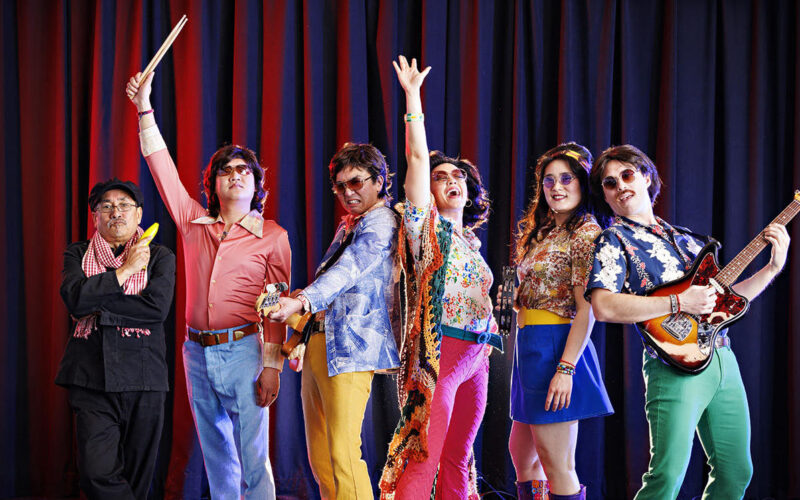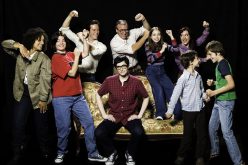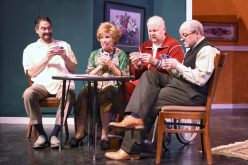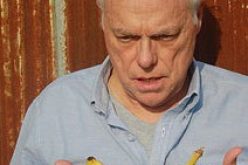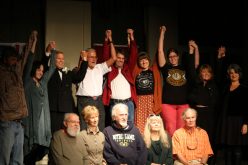MONICA HOOPER
mhooper@nwaonline.com
You’ll cry. You’ll laugh. You’ll dance.
Despite all of the tragedy inherent to “Cambodian Rock Band,” “dancing is heavily encouraged, especially at the end,” says director Nelson T. Eusebio III. But not for the whole story. TheatreSquared may need to once again supply tissues to playgoers during the musical’s run from Feb. 28 to March 24.
Written by Lauren Yee, the story in “Cambodian Rock Band” takes on family dynamics, trauma and reckoning with the past as the plot switches in time from the present to the Cambodian genocide under the Khmer Rouge led by Pol Pot. At the center of that story is a Cambodian rock band that performs Cambodian oldies and contemporary songs.
Eusebio says that bringing the music to the stage was among his biggest challenges. He had to find four Asian actors who could also play instruments or at least appear to play guitar, bass, keyboards or drums. Plus they had to be able to sing in Khmer — the official language of Cambodia, where the play is set.
“So we need you to sing, we need you to play an instrument, and we need you to do it in a foreign language that is probably not your own,” he laughs.
Some of the songs in the musical were written by L.A.- based band Dengue Fever, who are known for their covers of Cambodian rock mixed with other world music influences.The band was founded by brothers Zac and Ethan Holtzman, who were in separate countries when they discovered the rock bands whose sounds were silenced by Pol Pot’s army.
“In the ’90s, my brother was traveling in Cambodia. And the person he was traveling around with actually got dengue fever, and they were taking him to a hospital in this truck,” Zac Holtzman remembers. On the way to the hospital, Ethan first heard Cambodian rock music played by the truck’s driver. Back in the States, Zac was working at a record shop and heard a compilation of oldies that included Cambodian rock musicians Ros Serey Sothea, Pen Ran and Sinn Sisamouth. The Holtzmans were hooked and wanted to know more.
Both musical, they decided to start a band covering Cambodian rock music, but neither spoke Khmer. Then they met a legitimate Cambodian pop star, Chhom Nimol, who was performing in Long Beach, and asked her if she’d want to sing with the band. Their self-titled first album is largely made up of covers from Cambodian rock ‘n’ roll of the 1960s and ’70s.
Over the last 20 years, Dengue Fever has released 11 albums — all of original material infused with all sorts of influences — including last year’s “Ting Mong.”
When Lauren Yee was writing “Cambodian Rock Band,” she reached out to Dengue Fever and told them about her plans for the play. Members of the band helped actors learn to play their songs and even sat in on workshops watching the drama take shape.
For the local production, Eusebio didn’t have a band specializing in the music for the production, but he had four actors who had starred in previous productions of the musical. He says those actors helped the narrative get to a really good place in a short period of time.
The director, who also helmed T2’s production of “Kim’s Convenience” last year, says that the story is one that many children of immigrants can relate to, especially first-generation Asian Americans.
“Neary, who’s the daughter of Chum, who doesn’t know about all of the things that happened to her dad during the Khmer Rouge takeover of Cambodia, is really looking to find a way to connect,” he says. The child of parents who lived under Ferdinand Marcos’ martial law in the Philippines, he relates to her feelings.
“When I connected to the story was understanding my parents who, much like Chum’s parents and much like Chum himself, fled to this country to try and find a better life — a life that was safe and stable and better not just for them but better for their children,” Eusebio says.
“As we’ve continued to work on the piece, another part that has become one of my favorites is the scene where the band is hanging out and celebrating the new year,” he goes on. “That scene is very near and dear to my heart in that it’s a bunch of young, talented, excited people falling in love with each other through the art of making music. As a younger theater person, that was definitely how I formed some of my closest friendships, through making theater with my friends in college or my friends right out of college.”
Since becoming aware of the music in the play, Eusebio admits to becoming a fan of Dengue Fever. e said that Jason Leibson, music director does an incredible job with the music in the play.
“There are moments when the music serves as a vehicle for that dramatic action. There are moments when the music serves as a support or a buoy to the mood or the feeling,” he says, whether that’s getting the audience pumped for the dancing with the band or illuminating the profound sadness felt by characters.
“I think what is the most exciting about the music is it provides this life force and this vitality, and it’s an act of resurrection,” he says, not just for the characters lost in the story, but for the audience.
“For some people, it’s going to be brand new. But for some of the Cambodian and the Khmer community that comes out, it’s going to feel hopefully, like we’re bringing their music, their songs, to life on stage.”
—
FAQ
‘Cambodian Rock Band’
WHAT — Backed by a live band, “Cambodian Rock Band” follows the story of a father who escaped a murderous regime returning home after 30 years in search of his wayward daughter. The cast includes Jojo Gonzalez as Duch; Alex Lydon as Ted Patpong/Leng; K Chinthana Sotakoun as Neary/Sothea; Greg Watanabe as Chum; Shawn Mouchepao as Rom/Journalist; and Eileen Doan as Pou/Cadre.
WHEN — 7:30 p.m. Wednesday-Friday; 2 & 7:30 p.m. Saturday; 2 p.m. Sunday, Feb. 28-March 24
WHERE — TheatreSquared in Fayetteville
COST — $49-$59
INFO — theatre2.org/cambodian-rock-band
—
FYI
The History
There’s no definitive count of how many people the Khmer Rouge killed during the 48 months of the Cambodian genocide in the 1970s — estimates are 1.5 to 3 million.
Led by Pol Pot, the Khmer Rouge sought to rid the country of all Western influences and specifically targeted Christians, Buddhists, Muslims and anyone deemed “intellectual.” The soldiers were even rumored to shoot people who wore glasses.
Those who weren’t executed were taken away from their families and placed in communes based on how much the Khmer Rouge trusted them. The regime claimed it was to eliminate competition for the greater good. They also destroyed books, music and art in another an attempt to reeducate those they didn’t kill.
Once Vietnam ousted the Khmer Rouge, many Cambodians left the country. Pol Pot died in 1998, and soon afterward the surviving leaders of the Khmer Rouge defected or were imprisoned. In 2010, a Cambodian court sentenced one of the former leaders of the Khmer Rhouge, Kaing Guek Eav (alias Duch) for crimes against humanity and grave breaches of the Geneva Conventions of 1949 and sentenced him to 35 years in prison, according to the American Holocaust Museum.

